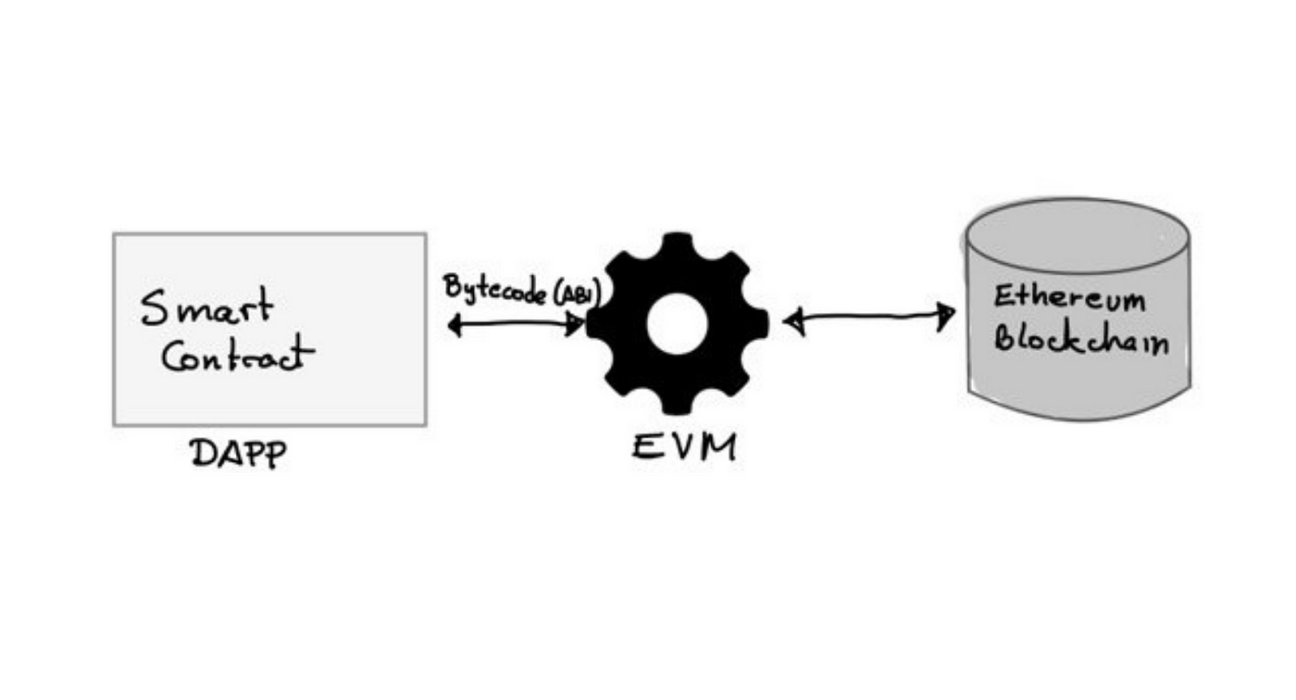If you know a thing or two about blockchain, you must’ve heard about The Ethereum Virtual Machine, or EVM. Basically, it’s a software that runs smart contracts on the Ethereum blockchain. When each new block is added, the EVM calculates the updated state of the entire network.
The EVM operates on top of Ethereum’s hardware and network of nodes. It takes various types of smart contract code and converts them into “Bytecode,” which is a format the network can read and execute.
EVM compatibility also extends beyond Ethereum. Chains like Polygon and Avalanche recognize smart contracts written for Ethereum. This allows developers to easily move their apps and tokens from Ethereum to these networks.
How Does EVM Work?
Here’s how EVM works: it processes smart contracts written in languages like Solidity, then converts smart contracts into “bytecode” that the EVM can read and execute.
Let’s see a breakdown of the key components within EVM:
The EVM consists of several key components, each serving a specific function. The stack is responsible for managing data during code execution. It tracks the current state while processing a contract.
The memory stores temporary data needed during transactions. The system keeps this data only for the duration of the transaction and discards it afterward.
The storage component holds contract data permanently on the blockchain. It stores important information securely and keeps it accessible across the network.
The last one is the execution component responsible for transaction processing and checks that their form is in line with the rules of the blockchain. It serves as a guarantee that smart contracts will be executed correctly and maintain system integrity.
The decentralized nature of EVM means that each node on the network independently processes the same code in order to maintain integrity in the blockchain.
Benefits of EVM
The EVM offers several advantages that have made it popular among blockchain developers:
- Transparency: The EVM is open-source, so anyone can view and verify the code.
- Security: Transactions on EVM are tamper-proof, ensuring user data stays secure.
- Interoperability: EVM-compatible chains allow applications to run across multiple platforms, providing flexibility to developers.
- Trustless Transactions: No intermediaries are required, as smart contracts self-execute based on preset rules.
Limitations of EVM
While EVM is powerful, it faces some limitations:
- Scalability: Processing transactions on-chain leads to slower speeds, especially as the network grows.
- Gas Fees: Users pay “gas” fees for every transaction, which can become expensive.
- Interoperability Challenges: Though EVM-compatible chains exist, integrating smoothly with non-Ethereum systems remains challenging.
Practical Applications of EVM
EVM is mostly used in decentralized finance (DeFi), along with many other applications. By using EVM in DeFi, users can take part in peer-to-peer lending, trading, and decentralized exchanges (DEXs). It also supports NFTs and many other decentralized applications.
EVM and the Future of Ethereum
EVM continues to evolve, and upgrades are targeted towards scalability and performance improvements. Solutions like Layer 2 rollups, like zk-rollups and optimistic rollups-help process transactions off-chain. They are expected to reduce congestion on the network along with cutting down the costs.
Improvements are regularly suggested to the EVM by Ethereum’s community through something called Ethereum Improvement Proposals, or EIPs for short.
Key Points to Remember
- EVM powers Ethereum’s smart contracts, enabling decentralized apps.
- Benefits include security, transparency, and interoperability.
- Challenges involve scalability and gas costs.
- Future Improvements focus on scaling solutions like Layer 2 rollups.
By offering safe and open applications for the expansion of the Ethereum ecosystem, EVM continues to be a vital component of blockchain development. As blockchain technology develops, EVM’s function will likewise evolve over time, paving the way for decentralized apps that are easier to use and more scalable.
Disclaimer: The information provided is not trading advice, Bitcoinworld.co.in holds no liability for any investments made based on the information provided on this page. We strongly recommend independent research and/or consultation with a qualified professional before making any investment decisions.


